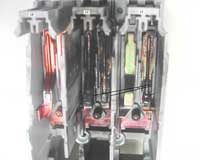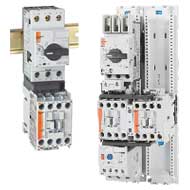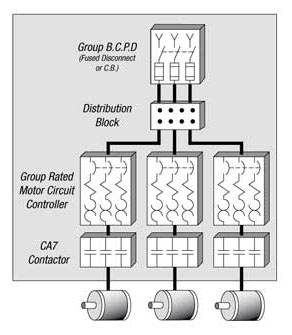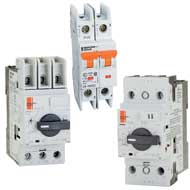Literature
Technical Tips & FAQs
Is there Life after a Short Circuit?
We often get questions concerning what damage may occur to our contactors, overload relays or manual motor starter and controllers during or following a short-circuit. In response to these questions we would like to start by clarifying that passing a UL short-circuit test for any of the above mentioned devices means "The current carrying parts may not move" when interrupting a short-circuit fault. Note that there is no promise that any of these devices are re-useable following a short circuit. This should not come as a surprise to most electrical personnel concerning contactors or overloads, but some people assume that a manual motor starter and controller is a circuit breaker and this assumption is in error. Some industrial controls manufacturers’ literature may reference manual motor starters and controllers as a circuit breaker, and that may be true in Europe under IEC rules, but manual motor starters are NOT circuit breakers under UL and NEC or CSA standards. We hope the following will help users understand the proper application of Manual Motor Starters as compared to Self-protected Combination Motor Controllers.
What the tests mean
Many electrical personnel assume that a manual motor starter and controller is a circuit breaker because some of them have thermal and magnetic response mechanisms. A manual motor starter and controller is tested and approved under UL508 Part III, Sections 72-75 entitled "Manual Motor Controllers". A molded case circuit breaker is tested and approved under UL489. Clearly, there are different tests required for each and they do NOT perform the same functions.

UL standards and NEC code covering molded case circuit breakers suggests that ALL circuit breakers should be inspected following interruption of a short-circuit to verify that the circuit breaker is operating properly. Note no one promised that a UL489 600 V class circuit breaker is reusable after a short circuit, but many people assume that to be fact. We get the impression that a circuit breaker is useable after a short-circuit because when we work on the toaster at home while it is plugged-in and trip the breaker; then we can simply go to the power panel and reset the breaker. Residential breakers are not subject to high fault currents (KA) like industrial facilities are exposed to. If a 25 KAIC breakers experiences a short-circuit fault on a power system capable of producing 24 KA then that breaker will most likely be damaged.

There is a BIG difference between the tests required for a "Manual Motor Starter and Controller" and a "Self-protected Combination Motor Controller" although they may look quite similar. A "Self-protected Combination Motor Controller" is tested and approved under UL508 Part IV and some have passed both Part III and Part IV which is to say they have mixed (or dual) approvals. A Self-protected Combination Motor Controller (sometimes referred to as Type E Combo) has to pass a "life after short-circuit test" that even Molded Case Circuit Breakers do not have to pass. Type E Combo controllers promise life after short-circuit while contactors, overloads, manual motor starters and even molded case circuit breakers DO NOT promise they are useable after interrupting a short-circuit. Further, a molded case circuit breaker can be used as a branch-circuit protection device (BCPD) for many types of loads including lighting, heaters, control circuit transformers, power supplies and motor loads under NEC 430-52C Option 1. Alternatively, a Self-protected Combination Motor Controller can be used for MOTOR loads under NEC430-52C Option 6. A manual motor starter and controller can NOT be used as a branch circuit protection device (BCPD) at any time.

A manual motor starter and controller may have a "Group Installation" rating which means it can be used to feed motors and/or other loads under a single BCPD per NEC 430-53. Under NEC 430-53 a single BCPD may protect a group of motors and/or other loads. Under Group Installation rules the single BCPD must be a set of fuses or a thermal-magnetic molded case circuit breaker selected per the options A, or B, or C under NEC 430-53C. It should be noted that the thermal-magnetic features or the withstand (KAIC) rating of a manual motor starter does NOT imply it can be used in place of a circuit breaker nor does UL testing promise that manual motor starters and controllers will be re-useable following a short-circuit on the load side. Please note that Sprecher + Schuh publishes the ratings of our KTA7 Self-Protected Combination Motor Controllers (which may also be rated as a manual motor starter and controller) in the technical sections of our e-catalog. We also show the ratings of a KTA3-100 manual motor starter and controller.
If a manual motor starter and controller only (like KTA3-100 or KT4 or some of our KTA7 that is only rated as a manual motor starter) does experience a short-circuit from the load, then the probable result will be that one pole will be damaged and stick open or may stick closed. This result should be expected since a manual motor starter and controller can NOT be used in place of a Branch-circuit short-circuit device (BCPD). A Self-protected Combination Motor Controller can be used as the BCPD and, in fact when in a tripped condition, is required to differentiate between an overload condition or a short-circuit condition. So, it is important to know the difference in ratings. We hope this article helps answer some questions about why charred (burnt-up) contactors, overload relays or manual motor starters and controllers, or even circuit breakers are not warranted to work after short-circuit.
Footnotes:
(1) KTA3-100 should never be used as a means of disconnect as it nor any other manual starter may well be "hot" on the load side after interrupting a short-circuit. This is exactly why we do not list KTA3-100 disconnect handles in our catalog. "Disconnect" is more than a word as UL has a test for suitability for use as a "Disconnect" and where in the branch circuit they can be applied. This subject is covered in the "Manual Switching Devices" white paper [PDF].
(2) Sprecher + Schuh has extensive white papers covering the application of UL489 circuit breakers versus Self-Protected Combination Circuit Breakers in more detail. We also offer information concerning the increasing popularity of the European Type 1 and Type 2 coordination under IEC which does have implications for reusability following a short-circuit which we will not try to cover in this article.
Categories: Circuit Protection, Motor Circuit Controllers
1662

